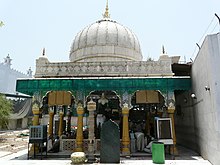Qutbuddin Bakhtiar Kaki
| Qutbuddin Bakhtiar Kaki | |
|---|---|

Dargah of Qutbuddin Bakhtiyar Kaki in Mehrauli, Delhi.
|
|
| Religion | Islam |
| Lineage | Chishti Order |
| Other names | Malik-ul-Mashaa'ikh |
| Personal | |
| Born | 1173 Osh in Transoxiana (present-day Kyrgyzstan) |
| Died |
1235 14th Rabi' al-awwalDelhi |
| Resting place |
Mehrauli, Delhi 28°31′09″N 77°10′47″E / 28.519303°N 77.179856°E |
| Senior posting | |
| Based in | Delhi |
| Title | قطب الاقطاب Qutub ul Aqtab |
| Period in office | Early 13th century |
| Predecessor | Moinuddin Chishti |
| Successor | Fariduddin Ganjshakar |
1235
Qutb ul Aqtab Hazrat Khwaja Sayyid Muhammad Bakhtiyar AlHussaini Qutbuddin Bakhtiar Kaki (Urdu: حضرت خواجہ سیّد محمد قطب الدین بختیار کاکی) (born 1173-died 1235) was a Muslim Sufi mystic, saint and scholar of the Chishti Order from Delhi, in what is now India. He was the disciple and the spiritual successor of Moinuddin Chishti as head of the Chishti order, and the person to whom the Qutb Minar, Delhi is dedicated. Before him the Chishti order in India was confined to Ajmer and Nagaur. He played a major role in establishing the order securely in Delhi. His dargah located adjacent to Zafar Mahal in Mehrauli, and the oldest dargah in Delhi, is also the venue of his annual Urs festivities. The Urs was held in high regard by many rulers of Delhi like Qutbuddin Aibak, Iltutmish who built a nearby stepwell, Gandhak ki Baoli for him, Sher Shah Suri who built a grand gateway, Bahadur Shah I who built the Moti Masjid mosque nearby and Farrukhsiyar who added a marble screen and a mosque.
His most famous disciple and spiritual successor was Fariduddin Ganjshakar, who in turn became the spiritual master of Delhi's noted Sufi saint, Nizamuddin Auliya, who himself was the spiritual master of Amir Khusrau and Nasiruddin Chirag-e-Delhi.
...
Wikipedia
